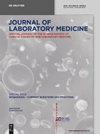一种新的基于机器学习的终末期肝病患者生存预测
IF 1.1
4区 医学
Q4 MEDICAL LABORATORY TECHNOLOGY
引用次数: 0
摘要
摘要目的针对肝移植中移植物的短缺,需要进行风险分层和合理的分配规则。本研究旨在通过不同的机器学习算法,改进终末期肝病(MELD)评分模型,用于90天死亡率预测。方法回顾性分析莱比锡大学医院在肝移植评估过程中招募的654例患者的临床和实验室资料。在交叉验证设置中比较13种不同的机器学习算法并选择表现最佳的算法后,我们建立了一个新模型来预测终末期肝病患者的90天死亡率。结果惩罚回归算法在我们的机器学习算法基准中产生了最高的预测性能。为了支持一个更简单的模型,我们选择了最小的绝对收缩和选择算子(套索)回归。除了经典的MELD国际标准化比值(INR)和胆红素外,lasso回归选择了胱氨酸抑制素C而不是肌酐,以及IL-6、总蛋白和胆碱酯酶。新模型提供了更好的辨别和校准MELD和MELD与钠(MELD- na), MELD 3.0,或MELD- plus7风险评分。我们提供了一种新的基于机器学习的终末期肝病模型,该模型结合了合成和炎症标志物,并可能提高经典MELD评分,用于90天生存预测。本文章由计算机程序翻译,如有差异,请以英文原文为准。
A new machine-learning-based prediction of survival in patients with end-stage liver disease
Abstract Objectives The shortage of grafts for liver transplantation requires risk stratification and adequate allocation rules. This study aims to improve the model of end-stage liver disease (MELD) score for 90-day mortality prediction with the help of different machine-learning algorithms. Methods We retrospectively analyzed the clinical and laboratory data of 654 patients who were recruited during the evaluation process for liver transplantation at University Hospital Leipzig. After comparing 13 different machine-learning algorithms in a nested cross-validation setting and selecting the best performing one, we built a new model to predict 90-day mortality in patients with end-stage liver disease. Results Penalized regression algorithms yielded the highest prediction performance in our machine-learning algorithm benchmark. In favor of a simpler model, we chose the least absolute shrinkage and selection operator (lasso) regression. Beside the classical MELD international normalized ratio (INR) and bilirubin, the lasso regression selected cystatin C over creatinine, as well as IL-6, total protein, and cholinesterase. The new model offers improved discrimination and calibration over MELD and MELD with sodium (MELD-Na), MELD 3.0, or the MELD-Plus7 risk score. Conclusions We provide a new machine-learning-based model of end-stage liver disease that incorporates synthesis and inflammatory markers and may improve the classical MELD score for 90-day survival prediction.
求助全文
通过发布文献求助,成功后即可免费获取论文全文。
去求助
来源期刊

Journal of Laboratory Medicine
Mathematics-Discrete Mathematics and Combinatorics
CiteScore
2.50
自引率
0.00%
发文量
39
审稿时长
10 weeks
期刊介绍:
The Journal of Laboratory Medicine (JLM) is a bi-monthly published journal that reports on the latest developments in laboratory medicine. Particular focus is placed on the diagnostic aspects of the clinical laboratory, although technical, regulatory, and educational topics are equally covered. The Journal specializes in the publication of high-standard, competent and timely review articles on clinical, methodological and pathogenic aspects of modern laboratory diagnostics. These reviews are critically reviewed by expert reviewers and JLM’s Associate Editors who are specialists in the various subdisciplines of laboratory medicine. In addition, JLM publishes original research articles, case reports, point/counterpoint articles and letters to the editor, all of which are peer reviewed by at least two experts in the field.
 求助内容:
求助内容: 应助结果提醒方式:
应助结果提醒方式:


